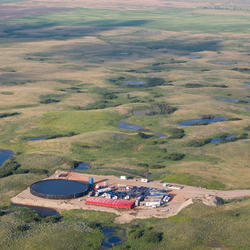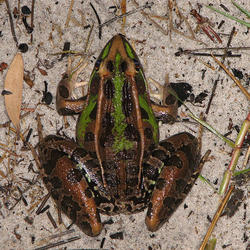Exposure Pathways
Exposure Pathways
Filter Total Items: 113
Long-Term Monitoring Reveals How Water and Biota in Remote Lakes Respond Differently to Changes in Atmospheric Deposition of Mercury
A comparison of regional mercury atmospheric deposition data with water, yellow perch, and dragonfly larvae samples from lakes in Voyageurs National Park indicates that decreases in mercury emissions resulted in mercury reduction in water from these remote lakes, but mercury declines in biota were significant in only one of three lakes, likely because resident biota integrate exposure over much...
Nationwide Occurrence
A National-scale approach is used to examine and analyze per- and polyfluoroalkyl substances (PFAS) prevalence and magnitude in watersheds and aquifers. As an initial step to fill known science gaps in the understanding of human and wildlife exposure, the team will provide a snapshot of PFAS in drinking water paired with bioaccumulation in fish and wildlife near known or suspected sources of...
Advanced PFAS Measurement Methods
Environmental Health Program scientists, in collaboration with other USGS scientists, are developing complementary field and laboratory methods and capabilities to detect and quantify a range of target and nontarget per- and polyfluoroalkyl substances (PFAS) and indicator compounds at low levels (parts per trillion) in a variety of environmental matrices. The PFAS Integrated Science Team is...
Energy Integrated Science Team
The Energy Lifecycle Integrated Science Team focuses on the potential for contaminant exposures in the environment that might originate from energy resource activities including, extraction, production, transportation, storage, extraction, waste management and restoration. Perceived health risks to humans and other organisms will be distinguished from actual risks, if any. If actual risks are...
Bioaccumulation of Mercury in Fish Varied by Species and Location in the Chesapeake Bay Watershed—Summary of Existing Data and a Roadmap for Integrated Monitoring
Fish mercury data from State monitoring programs and research studies within the Chesapeake Bay were compiled and summarized to provide a comprehensive overview of the variation in fish mercury concentrations among species and habitats within the watershed. These data are put into context with existing health benchmarks for humans, birds, and fish. Scientists also provide a roadmap for an...
Clothianidin Exposure Associated with Changes in Tadpole Behavior
During a laboratory exposure study, tadpole movement decreased with increased concentrations of clothianidin, a neonicotinoid pesticide. Decreased movement could affect a tadpole’s ability to forage, escape predation, and metamorphose before ponds dry.
Mercury Accumulation in Waterbirds (Black Rails) Related to Sediment Chemistry in San Francisco Bay Wetlands
The U.S. Geological Survey (USGS) assessed the effect of sediment chemistry, food web structure, and diet on mercury bioaccumulation in black rails in the San Francisco Bay watershed. Differences in mercury accumulation in the birds were related to differences in sediment chemistry in the wetlands.
Dragonfly Larvae are Effective Bioindicators of Mercury Exposure in Fish and Amphibians—Results of Citizen Science in 100 National Parks and Protected Places
Mercury concentrations were measured in dragonfly larvae across more than 450 sites in 100 national parks and protected places as part of a partnership among Federal agencies, academic researchers, and more than 4,000 citizen scientists. Mercury concentrations in dragonfly larvae were positively correlated with mercury concentrations in fish and amphibians living in the same aquatic environments...
Framework for Examining Stream Ecosystem Health in Areas of Shale Gas Development—A Multi-Parameter Watershed-Based Case Study in Pennsylvania
In a case study of 25 headwater streams in Pennsylvania, no statistically significant associations were determined between shale gas development and geochemical tracers of produced waters or measures of microbial and macroinvertebrate community composition. Although the results are specific to the region studied, the integrated biological and geochemical framework provides a tool for examining...
Food Web Changes Dampen Expected Reductions in Lake Trout Mercury Levels in Lake Michigan—Invasive Species Play Major Role
Combined analyses of mercury, nitrogen, and carbon isotopes in archived lake trout ( Salvelinus namaycush ) tissues and sediment cores in Lake Michigan from 1978 to 2012 indicated that lake trout mercury concentrations mirrored declines in mercury sources prior to the arrival of invasive species that changed mercury transfer through the food and dampened the expected decreases in mercury...
Mercury Isotope Ratios used to Determine Sources of Mercury to Fish in Northeast U.S. Streams
Mercury isotope analyses were used to distinguish different sources of mercury to fish in 23 streams along a forested-rural to urban-industrial land-use gradient in the Northeastern United States. The use of mercury isotope measurements in fish tissue allow for distinguishing different sources of mercury that are bioaccumulating into the food web. Mercury isotope signatures in fish in forested...
Science to Help Understand Exposure and Toxicological Effects of Environmental Mercury to Representative Birds
Exposure and toxicity of environmental mercury to birds can be enhanced or lessened due to the available sources and forms of mercury and other species dependent factors such as life stage, migratory patterns, foraging and nesting behaviors, transfer of mercury from mothers to eggs, and sex. For example, mercury exposure can lead to sublethal toxicological effects that can influence parental...













